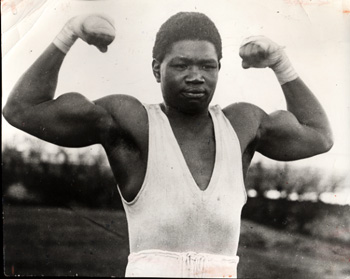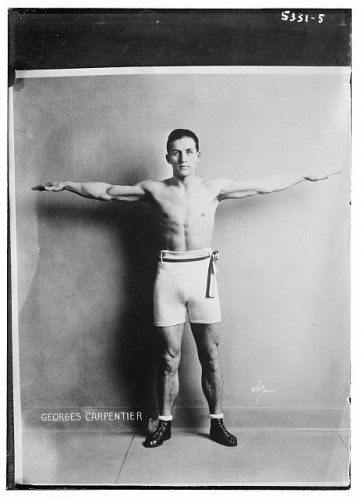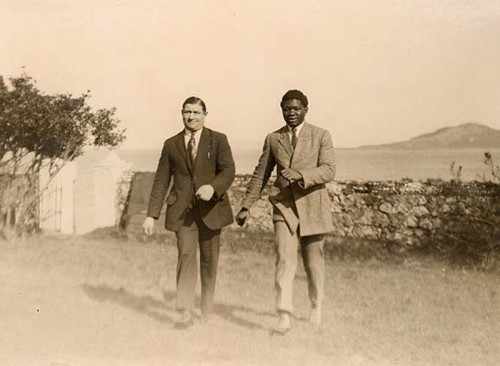The Fight that Wouldn’t Stay Fixed
How an apparent misunderstanding led to a brawl that turned into a donnybrook that became a legend
![]()
Despite the promoters’ best efforts, the 1922 light-heavyweight fight between the popular European champion Georges Carpentier and an obscure Senegalese brawler named Amadou Mbarick Fall, better known as “Battling Siki,” wasn’t supposed to be much of a fight. In the run-up to the September 22 event, newspapers confidently reported that fight fans could “expect to see the French idol win inside of six rounds.”
And yet more than 50,000 Parisians flocked to the Buffalo Velodrome, creating the first “million-franc” boxing match. Carpentier was a war hero beloved by his countrymen, and even though he had a lackluster record, Battling Siki was more than willing to help stir up interest in the fight. He was billed as the “Jungle Hercules,” and reporters described him as a man who fought “like a leopard,” with “great muscles” rippling under his dark skin and “perfect white teeth so typical of the negroid.” Siki had taken a hit on the head with a hammer, one paper stated, “and scarcely felt it.”
Even Siki’s own manager, Charlie Hellers was quick to point out the fighter’s “gorilla’s skill and manners” to reporters. “He’s a scientific ape,” Hellers said. “Just imagine an ape that has learned to box and you have Battling Siki.”
For his part, Siki told reporters that he was going to knock Carpentier out in the first round because he had plans to fight the world heavyweight champion next. “Tell Jack Dempsey he’s my next meat,” Siki was quoted as saying.
In truth, the fighter was born and raised in the Senegalese city of Saint-Louis and moved to France as a teen. “I have never even seen a jungle,” he would say later. He was often spotted around Paris dressed in expensive suits and fancy hats, sometimes with his pet monkey perched on his shoulder. His training, it was said, consisted of “caviar and cognac,” and he preferred doing his “roadwork on a dance floor.”
On the afternoon of September 22, fight fans packed the velodrome to see Carpentier defend his title. Nicknamed the “Orchid Man” for the corsages he often wore with his tailored suits, Carpentier had been fighting professionally since he was 14. Although he was coming off a failed attempt to win Dempsey’s heavyweight title, he’d helped secure boxing’s first million-dollar gate. Fighting again as a light-heavyweight, the Frenchman’s future was still bright—so bright that Carpentier’s handlers were taking no chances. They offered Battling Siki a bribe to throw the fight. Siki agreed, under the condition that he “didn’t want to get hurt.” What followed was one of the strangest bouts in boxing history.
Although Siki later admitted that the fight was rigged, there’s some question as to whether Carpentier knew it. Early in the first of 20 scheduled rounds, Siki dropped to a knee after Carpentier grazed him, and then rose and began to throw wild, showy punches with little behind them. In the third, Carpentier landed a powerful blow, and Siki went down again; when he got back on his feet, he lunged at his opponent head first, hands low, as if inviting Carpentier to hit him again. Carpentier obliged, sending Siki to the canvas once more.
At that point, the action in the ring turned serious. Siki later told a friend that during the fight, he had reminded Carpentier, “You aren’t supposed to hit me,” but the Frenchman “kept doing it. He thought he could beat me without our deal, and he kept on hitting me.”
Suddenly, Battling Siki’s punches had a lot more power to them. He pounded away at Carpentier in the fourth round, then dropped him with a vicious combination and stood menacingly over him. Through the fourth and into the fifth, the fighters stood head to head, trading punches, but it was clear that Siki was getting the better of the champion. Frustrated, Carpentier charged in and head-butted Siki, knocking him to the floor. Rising to his feet, Siki tried to protest to the referee, but Carpentier charged again, backing him into a corner. The Frenchman slipped and fell to the canvas—and Siki, seemingly confused, helped him get to his feet. Seeing Siki’s guard down, Carpentier showed his gratitude by launching a hard left hook to Siki’s head just before the bell ended the round. The Senegalese tried to follow Carpentier back to his corner, but handlers pulled him back onto his stool.
At the start of round six, Battling Siki pounced. Furious, he spun Carpentier around and delivered an illegal knee to his midsection, which dropped the Frenchman for good. Enraged, Siki stood above him and shouted down at his fallen foe. With his right eye swollen shut and his nose broken, the Orchid Man was splayed awkwardly on his side, his left leg resting on the lower rope.
Siki returned to his corner. His manager, Charlie Hellers, blurted out, “My God. What have you done?”
“He hit me,” Siki answered.
Referee M. Henri Bernstein didn’t even bother counting. Believed by some to be in on the fix, Bernstein tried to explain that he was disqualifying Siki for fouling Carpentier, who was then being carried to his corner. Upon hearing of the disqualification, the crowd unleashed a “great chorus of hoots and jeers and even threaten the referee with bodily harm.” Carpentier, they believed, had been “beaten squarely by a better man.”
Amid the pandemonium, the judges quickly conferred, and an hour later, reversed the disqualification. Battling Siki was the new champion.
Siki was embraced, just as Carpentier had been, and he quickly became the toast of Paris. He was a late-night fixture in bars around the city, surrounded by women, and he could often be seen walking the Champs-Elysees in a top hat and tuxedo, with a pet lion cub on a leash.
Carpentier fought for a few more years but never never reclaimed his title. Retiring from the ring, he toured the vaudeville circuits of the United States and England as a song-and-dance man. Battling Siki turned down several big fights in the United States to face Mike McTigue in Ireland. That the bout was held on St. Patrick’s Day in Dublin was likely a factor in Siki’s losing a controversial decision. He moved to New York City in 1923 and began a downward spiral of alcohol abuse that led to countless confrontations with the police. By 1925, he was regularly sleeping in jail cells after being picked up for public intoxication, fighting and skipping out on bar debts.
In the early hours of December 15, 1925, Amadou Mbarick Fall, aka Battling Siki, was wandering through the Hell’s Kitchen section of New York’s West Side when he took two bullets in his back and died on the street. Just 28 years old, Siki was believed to have been killed over some unpaid debts, but the homicide remains unsolved. Adam Clayton Powell presided over Siki’s funeral in Harlem, and in 1991, the pugilist’s remains were brought back to Senegal.
Sources
Books: Peter Benson, Battling Siki: A tale of ring fixes, race & murder in the 1920s, The University of Arkansas Press, 2006.
Articles: “Dempsey’s My Meat,” Chicago Daily Tribune, September 18, 1922, “Knocked Out, Battling Siki is Borne From Ring of Life Forever,” The New Amsterdam News, December 29, 1925. “Siki Scientific Ape, Says Manager,” The Atlanta Constitution, October 1, 1922. “Siki Like a Leopard,” Boston Daily Globe, September 25, 1922. “Million Franc Gate For Carpenter’s Bout with Battling Siki,” Boston Daily Globe, September 22, 1922. “The Sidewalks of New York,” Boston Daily Globe, November 29, 1925. “Saki is a Gorilla, Says Manager,” New York Times, September 26, 1922. “Carpentier Crumbles Before Negro Wonder; Flattened in Sixth,” The Hartford Courant, September 25, 1922. “Negro Tumbles Idol of France,” Boston Daily Globe, September 25, 1922. “The Fix Was In—but Then Battling Siki Got Mad,” by Roy McHugh, Sports Illustrated, April 24, 1989.
/https://tf-cmsv2-smithsonianmag-media.s3.amazonaws.com/accounts/headshot/gilbert-king-240.jpg)



/https://tf-cmsv2-smithsonianmag-media.s3.amazonaws.com/accounts/headshot/gilbert-king-240.jpg)